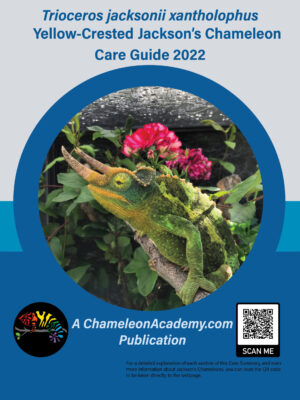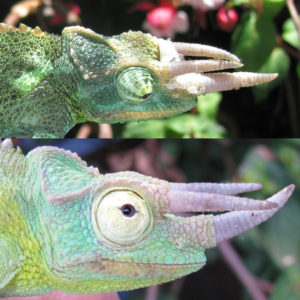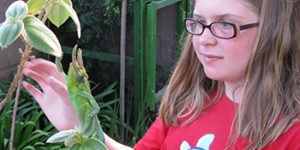Introduction to the Jackson's Chameleon
If there was one chameleon that embodies the most about what makes chameleons bizarre it would be the Jackson’s Chameleon. With their pre-historic three horns, strong prehensile tail, and giving live birth you have a modern day fantastical dinosaur in a mild-mannered package.
Jackson's Chameleon Care Summary
I have multi-media resources available for Jackson’s Chameleon research. Included here is a short audio summary of Jackson’s Chameleon Care and a single page Care Summary sheet. You may click the audio player to hear the summary (you can also find it on the Chameleon Academy Podcast through your podcast app) and you may download the care summary .pdf below. Following this, just scroll further for a detailed care summary of the Jackson’s Chameleon!
The Jackson’s Chameleon Care Summary distills the most important aspects of husbandry care into an easily referenced handout. But chameleon care is, unfortunately, much more involved than can be presented on a summary sheet. Therefore, you may use this sheet as a reference and return to this page where we will go over each and every aspect that is on the summary sheet in detail.
The Yellow-crested Jackson’s Chameleon (Trioceros jacksonii xantholophus) and the Machakos Hills Jackson’s Chameleon (Trioceros jacksonii jacksonii) have identical care.
Natural History
Trioceros jacksonii, the Jackson’s Chameleon is made up of three subspecies that occur in the mid to high elevations of Mt. Kenya in Kenya and Mt. Meru in Tanzania. The largest of the sub-species, the Yellow-crested Jackson’s Chameleon, Trioceros jacksonii xantholophus, was imported to Hawaii for the pet trade, escaped, and established a population there. Most of the Jackson’s seen in the US pet trade over the last 20 years has been from the Hawaiian population.
They are higher elevation chameleons which means they are designed for mild day time temperatures and cooler night time temperatures. Being high altitude, they have developed the ability to retain their eggs and incubate them inside the mother’s body resulting in live young being born. Their ability to have multiple litters from one mating causes regular panic as new keepers who only have a female are surprised by babies being born.
Trioceros jacksonii xantholophus, or “Xanths” as they are affectionately known, are the largest of the subspecies. They are an overall lemon-lime green with the males having yellow spikes down their backs which earns them their common name of “Yellow-crested Jackson’s Chameleon”. The males have three horns while the females have none. There are occasionally specimens of females with small attempts at horns, but these remain quite rare.
Trioceros jacksonii jacksonii is a catch-all subspecies which covers everything which isn’t a T.j.xantholophus and isn’t a T.j.merumontanus. And that is quite a bit. It covers diverse populations that appear different, are geographically isolated, and live at different elevations. There is no doubt that this subspecies will be broken up further. The most notable member of this subspecies comes from the Machakos Hills region. The Machakos Hills Jackson’s Chameleon is of a smaller build than the Xanths, but the brightest colored males have a vibrant yellow swash across their flank and blue cheeks. The females cause no end to confusion as they, too, can have horns. They will have either three horns like the male or one rostral horn. Their elevation is similar to T.j.xantholophus and their care is identical.
Trioceros jacksonii merumontanus, or the Mt. Meru Jackson’s Chameleon, is found on Mt. Meru in Tanzania. It is a much higher elevation chameleon and so is acclimated to deeper nighttime temperature drops and higher UVB levels. It is small and sometimes called the Dwarf Jackson’s Chameleon. This is a colorful species with extra long horns for its little body. The females will have one horn.
An important thing to note is that the Jackson’s Chameleons have temporal glands at the point where the top jaw hinges with the bottom jaw. At this juncture the temporal gland produces a pungent odor that is speculated to aid in either attracting insects or as an anti-predator measure. This is not bothersome to the human nose, but this gland does tend to get infected when the chameleon’s immune system is compromised. Jackson’s Chameleon keepers make a habit of watching their chameleons’ mouths regularly.
Yellow-crested Jackson's Chameleon (Trioceros jacksonii xantholophus)
Male

Female

Machakos Hills Jackson's Chameleon (Trioceros jacksonii jacksonii)
Male
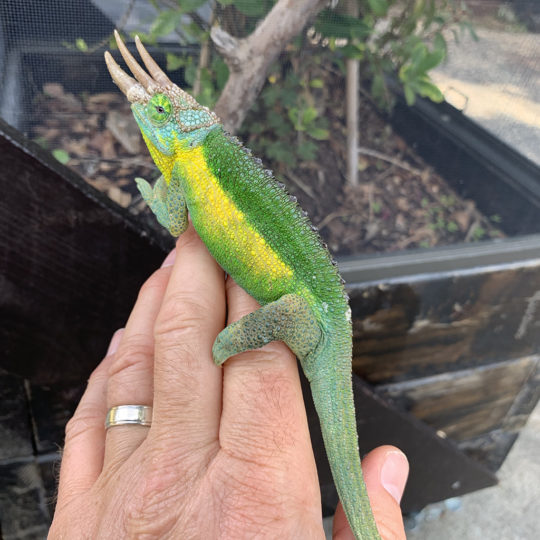
Female

Mt. Meru Jackson's Chameleon (Trioceros jacksonii merumontanus)
Male

Female
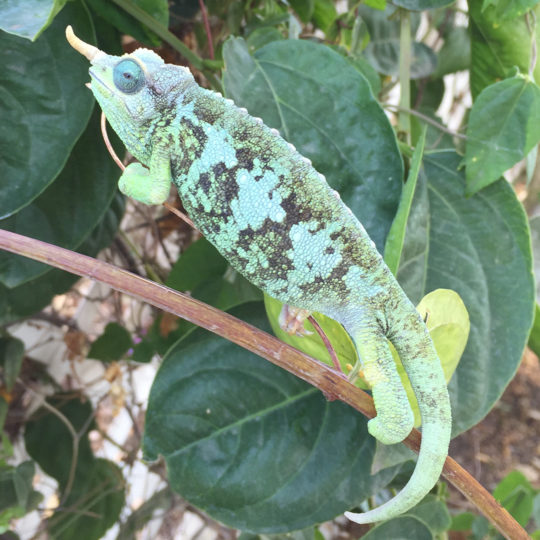
Are we keeping our Jackson's Chameleons correctly?
Morphs
Occasionally, there will be talk about the red phase Jackson’s Chameleon. Some females develop reddish colors as juveniles and can carry this for a long time. But eventually they turn green. There will always be variation within a species and the reddish colors is within the genes of the Jackson’s Chameleon. So there could be a female whose genes decided not to do their green transition. Technically, this can be considered a morph, but practically speaking, we do not have lines of Jackson’s Chameleons reliably producing reddish offspring. So if you purchase a Jackson’s Chameleon being sold as the “red morph” just be aware of the nature of this “morph”. The fact that this has been talked about (and sold) for decades, but you would be hard pressed to find one if you wanted to speaks to how reliable this morph is.
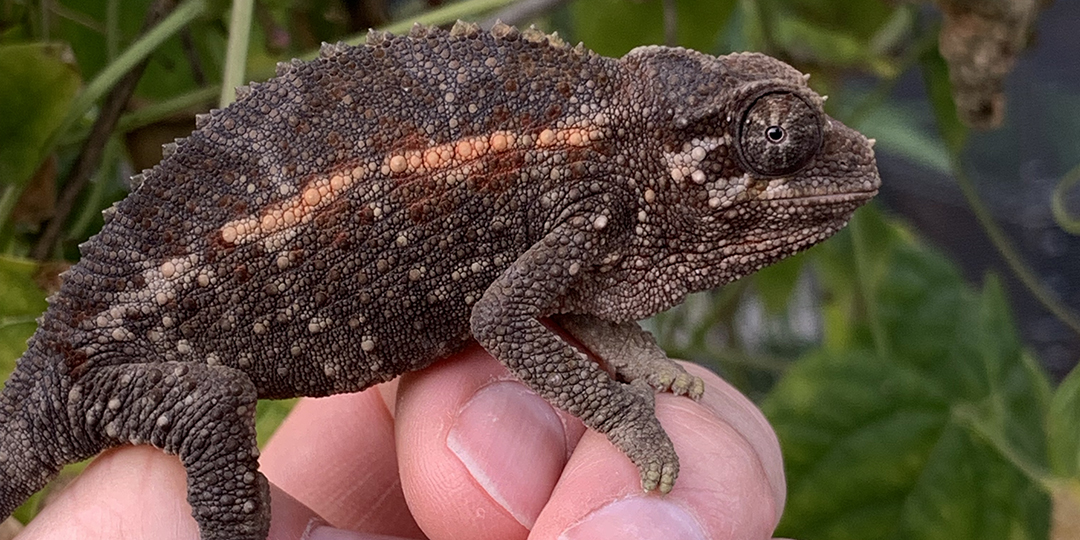
Personality

The Jackson’s Chameleon has a mild personality. While there certainly are individuals that will stand their ground, most of them will calm right down when removed from their perch. This, though, should not be taken as an indication that they enjoy human interaction. The Jackson’s chameleon body language is much more subtle than the Veiled or Panther Chameleon’s is and, to the inexperienced keeper, opens up a space for the keeper to project their desires for a lovable mascot onto their chameleon. This places avoidable stress on the chameleon.
But for the observant keeper, the Jackson’s Chameleon provides a delightful experience. Over time they will come to know you as the food bringer and the females especially tend to ignore you and concentrate on the food you bring. You will find them crawling over your hand to get at the food before you can put it properly in their cage. But this takes time and patience and an appreciation for the long term subtle changes.
Purchasing Jackson's Chameleons
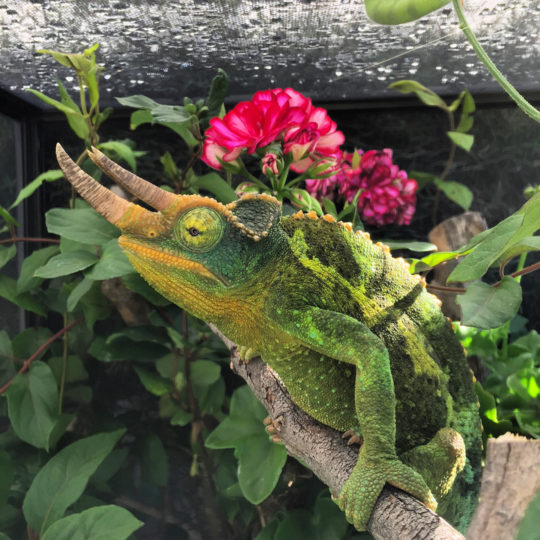
Because of the multiple geographical origins and the live birth it can be very confusing what it is you should be looking for and what it is you are buying. So, here is the layout.
In Europe, it is not profitable to smuggle Jackson’s of Hawaiian origin so Jackson’s Chameleons there are from Africa.
In the US it is illegal to collect Jackson’s Chameleons to sell. This is so people do not get the idea that they want to release other species on Hawaii to have a cheap breeding facility. But the vast majority of Jackson’s Chameleons sold in the US are here illegally from Hawaii. There are rumors that populations on the mainland have been started from Hawaiian imports, but, as these would be started with the intention o0f harvesting the chameleons, the people doing this would not announce their location.
If you see a cage full of Jackson’s Chameleons at a show or reptile store they are most likely Xantholophus from Hawaii.
There are occasional imports from Kenya. And these come to chameleon enthusiasts that want to see the strong native bloodlines established in captivity instead of the inbred Hawaiian lines. The entire Hawaii population was started from 36 individuals in the 1970s. It is unknown what the sex ratio of those founder stock was or how many of them survived to reproduce, but the population bottleneck has been seen in smaller body size and crooked horns. If you plan on breeding I strongly suggest you get in touch with the Kenyan Xanth Project and obtain bloodlines from Kenya. They will be more expensive, but the quality is much higher.
In all instances I recommend getting a captive born baby. This is no different, but there is a catch. Since females tend to give birth in inopportune times, they often give birth at the facility of the importer. Although this is technically captive born you are getting very few of the benefits that are understood to go with a captive born baby. You are not having the benefit of having the parents cared for by an experienced breeder to get the optimal nutrition and health of the mother throughout pregnancy and delivery. You are not getting the benefit of the baby getting the best attention and care being raised up. The babies will be all crammed together in a cage and sold off way too young. The Kenyan Xanth Project breeders hold their babies for at least four months and usually six months. This is quality. If you are getting a cheap baby that is small enough to perch on your finger tip then you are getting a harvested baby. I say this only to encourage you to avoid purchasing one of these in the first place. Seek out a dedicated breeder. If you already have purchased one then please read on as that little guy deserves the best shot at life possible and we will do everything possible to give it to him!
When Yellow-cresteds from Kenya come in they usually come with Machakos Hills Jackson’s as well.
At the time of this writing, the Mt. Meru Jackson’s Chameleon is not available as Tanzania is closed for export. There is a small captive population in Europe, but I am unaware of any in the US or Canada.

Imported Hawaiian Jackson’s Chameleons waiting to be sold.

A baby at the minimum size that is usually sold by the Kenyan Xanth Project members.
Cage Type and Size

The minimum cage size for both males and females that allows the creation of a suitable environment is 2’ x 2’ x 4’ tall, but males, especially, get to a size where a wider cage would be appreciated. Since they are comfortable in the 70s F , which matches our home comfort levels, a screen cage is often a good choice for cage type, but to produce the high nighttime humidity a hybrid cage with three solid sides is more effective.
House males and females separately.
Jackson’s Chameleons are housed in the Forest Edge style cage interior. A forest edge cage provides the open basking area and the densely leafy area where they can retreat, hide, and feel safe. This retreat area is critical for their well being. Notice in the pair of cages shown here that there are distinct open and leafy areas. This is what a Forest Edge cage will look like. The most overlooked aspect of a chameleon cage is the visual retreat where the chameleon can hide away when they desire privacy. This is critical for creating an effective chameleon environment.
Note that Jackson’s Chameleon males, during breeding season, may get restless and want to mate. This is especially the case when a female is in visual range. During these times the male will relentlessly crawl the sides of the cage and could injure himself from repetitious movement and rubbing. No cage will be big enough during this time. If you have a female, this would be the time to try mating. I have experienced this during Spring/Summer time.
Ambient Temperature
Ambient temperature is what most of the cage will read. If you have a screen cage this reading will be suspiciously similar to your room conditions. The basking bulb creates a warm microclimate that will dissipate in a relatively short distance.
Jackson’s Chameleons require mild temperatures and can start to show heat stress when exposed to temperatures in the 80s. And if they do not get a 10 to 20 degree F nighttime drop they gradually decline in health. This is thought to be due to exhaustion from not having a restful sleep. The temperature you will be able to provide is a significant consideration when thinking about a Jackson’s Chameleon. For many of us, air conditioners are part of Jackson’s Chameleon husbandry.
The question frequently arises as to how they can survive in Hawaii if they need these mild temperatures and nighttime drops. I hear from a number of scientific opinions and there is not a consensus as to whether the Hawaiian population is truly as healthy as the Kenyan. But what drives my continued advice to follow the nighttime drops of their Kenyan elevation is that in the wild they are able to survive a wider range of conditions due to being able to find more microclimates than we can provide in our homes. Overall, when we try to create an environment in our home we have much less leeway to fudge the limits. We do not have all the influences of airflow and humidity and the myriad of other minor influences that add up. We can try to recreate the airflow and the humidity cycles, but we do not do as well as nature does and cannot reproduce all the options and microclimates they can find.. So, when we look to nature to figure out what to replicate we look at the original natural conditions for the species. The places where they have created feral populations only show how great their tolerance range is for conditions outside of optimal. If we use these conditions to justify giving less than optimal conditions in our husbandry then we remove a certain amount of buffer room we have for something to go wrong.
Basking Temperature
A low nighttime temperature is a requirement for a healthy Jackson’s Chameleon. But your chameleon will need to warm up in the morning to get a good start on the day. In the wild, chameleons look to the sun rise and bask until their body temperature is sufficient for optimal hunting, digestion, and general function.
In captivity we give them this warm up through a basking bulb which is usually an incandescent bulb shining on their basking branch.
We need to be careful when setting up this bulb as it is very easy to burn your chameleon. Chameleons do not seem to have a keen sense of when they are being burned. And this is the reason that we will be encouraging basking bulbs to be mounted above the cage instead of on the cage top. The closer to the bulb, the more difference in temperature can happen in an inch. The ideal scenario is to have a higher wattage bulb further away. This produces a wider, and “gentler” heated area that has no burn risk.
For temperature we are looking for something in the mid 80s. But the exact temperature is not that important. It is more important to set it up so you feel a warm and gentle heat on the back of your hand when you place it where the top of the head of your chameleon would be when he is basking. Your main purpose is to set up a safe temperature to start with and then you will adjust the bulb distance based on your chameleon’s behavior. If your chameleon shows the following behaviors, bring the bulb closer
- Huddling under the bulb for more than 30 minutes
- Hanging from the top screen panel under the bulb
- Remaining dark and lethargic. After basking, they should take on resting colors.
The issue with relying on behaviors as a signal to move the bulb further away is that they generally are physical damage to the body such as gray burned areas, open wounds, and melted back spines. And it is concerning how long this kind of situation goes on before the keeper realizes what is going on. So this means the chameleon is basking even though it is too hot. Thus it is better to start low rather than high. The mid 80s F is a safe range to start off with. You can even start at the low 80s if you would like to be cautious. But always do the back of the hand test and watch behavior.
Humidity
Jackson’s Chameleons experience high humidity nights and mid to low humidity days. A nighttime humidity of 75% to 100% and then a drop to 30-50% during the day will allow them to engage in their natural humidity cycle. The exact numbers are not critical. There are two important aspects. 1) during high humidity times keep the air moving. Often cages are modified to enclose sides to impede airflow so a fogger can increase humidity. In this case have a ceiling fan or computer fan mounted to the top of the cage make sure that the “fog bank” circulates. Stagnant air, regardless of how humid, is unhealthy. 2) All surfaces must be dry during the day. Even if humidity is higher than the numbers listed, if the surfaces are dry then there shouldn’t be a health problem. It is when surfaces, such as the branches the chameleon climbs on are constantly wet the feet get sores and bacteria/fungus/mold is able to take a hold.
Lighting
Jackson’s Chameleons take the standard bright light that we put on our chameleon cages. A quad High Output T5 fixture the width of your cage with four 6500K fluorescent bulbs will light a 4’ tall cage nicely. A 12 hours on and 12 hours off cycle is used. Kenya is close to the equator and so this 12 on/12 off does not have to change through out the year.
Your chameleon will need it bright inside his cage. The biggest cage deficiency behind no hiding place, is insufficient light where, when you look at the cage, the chameleon looks like it is in a cave with a skylight. A bright cage will allow plants to grow and your environment to be vibrant.
Natural sunlight through a window is excellent, but dangerous. Sunlight tends to be too powerful and could overheat your chameleon. Be careful with sunlight.
UVB
The most effective and reliable way to producing UVB for your chameleon is with linear T5 high output fluorescent tubes. These bulbs may go into a multi-bulb fixture, but are most effective in a single bulb reflector. I highly recommend using a single bulb reflector for your UVB source as it gives you not only the full power of the bulb (your UVB gets soaked up by other bulbs), but it gives you full control over the UVB strength that hits the basking area depending on how high you raise the fixture above the cage. But if a multi-bulb fixture is the only option then you simply get a high power UVB bulb.
Presently we are targeting an UV Index of 3 at the basking branch with a maximum of UVI 6 to allow for sufficient vitamin D3 synthesis. This is generally what you can generate using a T5 HO Arcadia 6% or Zoomed Reptisun 5.0 in a single bulb reflector at a basking branch 6″ inches from the light going through a standard screen cage top panel. If you are using a multi bulb fixture the rough estimate is to jump up to the 12% or 10.0. These numbers are all general estimates as each reflector will have it’s own reflection properties and each bulb will have different strength depending on age. Luckily, this does not have to be an exact value. Ballpark is fine!
But members in the community are experimenting with higher levels of UVB. In all of this it is critical that the chameleon can escape the light and hide in the plants, but the higher the elevation the chameleon lives the more intense UVB they will encounter. Jackson’s Chameleons live right around the same elevation as Veiled Chameleons and so will take the same UVB levels, but certain locales, including T.j.merumontanus, range much higher up the mountain and would be expected to encounter high levels of UVB. How necessary these higher levels for D3 production are yet to be determined, but Mario Jungmann, who bred Trioceros hanangensis, a very high altitude species, shares that it wasn’t until he gave higher levels of UVB that their proper colors came out. There is certainly much more to be learned here. Both the Yellow-crested and Machakos Hills subspecies come from mid elevations and the target of UV Index between 3 and 6 is our working range at this time. This could shift up slightly with more experimentation.
Note: It is unclear where an often stated idea that Jackson’s Chameleons take less UVB than Veiled Chameleons originated. Jackson’s certainly do not tolerate as much ambient heat as Veiled Chameleons, but researching breeders with UV meters and comparing results indicates that the effective UVB intensity is the same. They do come from the same basic elevations and so the UVB levels would be comparable.
UVB Meters are an expensive piece of equipment, but are a valuable tool in setting up your chameleon’s environment. If you can get one – do it!
Setting up the lighting and hydration schedule
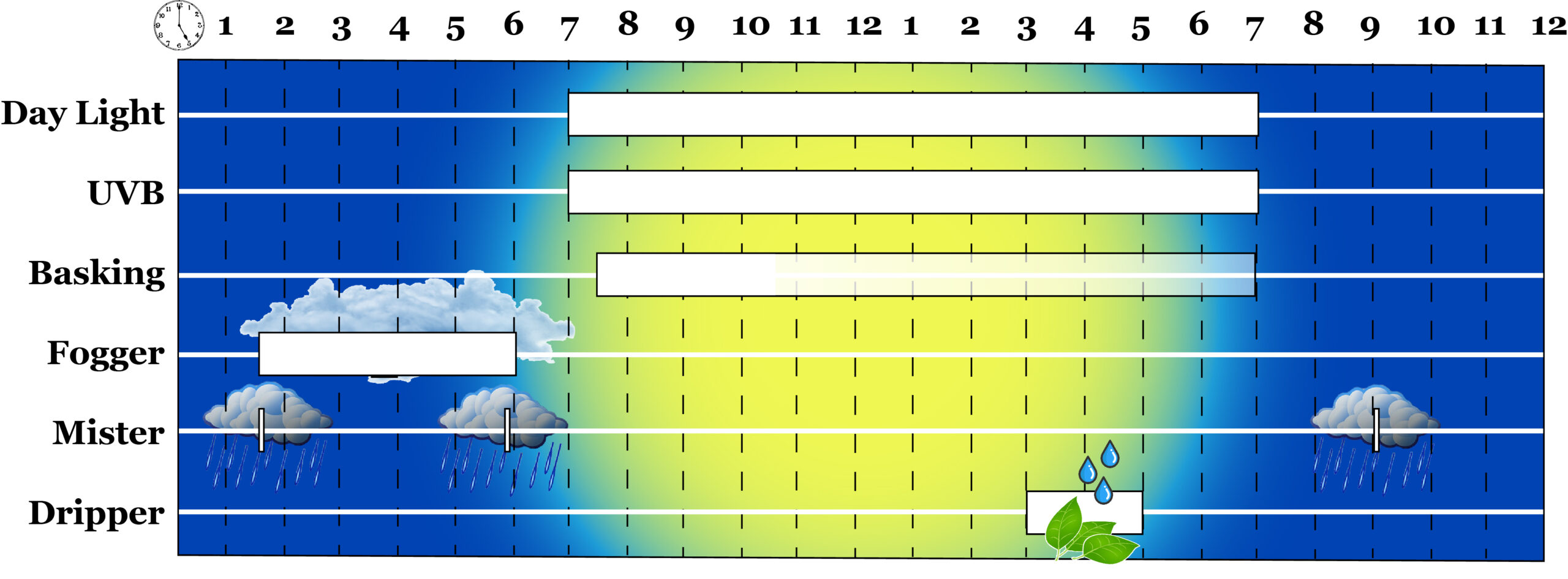
When we set up our daily schedule we are attempting to replicate the wild conditions that the chameleon has grown to expect. Let’s start at midnight.
At midnight the chameleon has been asleep for many hours. It is dark and, although the moon waxes and wanes, chameleons will seek out dark places to sleep. They see light of all colors just fine and any light can disturb their rest.
As the early morning progresses the humidity rises. Fog banks can start to form and the chameleon is breathing in moist air. This high humidity forms an important part in their natural hydration. To simulate this, we turn ultrasonic humidifiers on around 1:30AM. The fog from the humidifiers tends to bounce off of surfaces and roll out the cage so we run the misting system for a couple of minute to coat the cage in a layer of water. This helps the fogger be more effective and the fog tends to stick around. The fogger go from 1:30 to 6:00 in a 30 minutes on and 30 minutes off pattern. This is to protect against too much fog. This is wise when you have closed in three or more sides of your cage to retain humidity. If you have a completely screen cage then you may leave it on the entire time. This all is done so the chameleon can breathe in the humidity. Just before the lights come on the misters are run for another couple of minute to make sure that when the chameleon wakes up it wakes up to surfaces covered in “dew”. This is a natural source of water for them even in their dry season. Once the dew is laid down the lights can come on.
Around 7AM the daylights come on. This can include the UVB light if they are the same fixture. If they are separate fixtures then save turning the UVB light on to correspond to when the basking bulb is switched on. I like to leave the daylight bulbs on for 15 or 30 minutes to give the chameleon a chance to leisurely lick whatever dew they want. I then turn the basking bulb on so they can warm themselves up.
As the ambient temperatures start to warm there is no longer the need for a basking lamp and it is shut off. The actual time that the basking lamp is on will depend on your chameleon’s needs. Watch the behavior. If the routinely get the warmth they need in 30 minutes and then climb away with content colors to hunt then reduce your basking time to that time that they make use of the warmth. If they need the warmth for a longer period of time then leave the basking bulb on longer or consider increasing the temperature slightly. Watch your chameleon and they will tell you what they need. With a screen cage there is usually no issue leaving it on for the day, but if your ambient daytime temperatures start getting to the high end of their comfort, you can shut the basking lamp off.
Sometime during the day (I start at 3PM) start your dripper. This is a backup hydration strategy just to make sure they have enough water. While it is true they do not have drippers every day in the wild during the dry season, they also are not needing to reconstitute dry calcium powder on all their feeders. The advantage of running a dripper is that it is completely optional for them and, as a bonus, it also allows you the opportunity to ensure your plants get watered. Place it above a different plant each day and through out the week, all plants will get watered. It is not critical when you start the dripper. In this schedule I have it in the late afternoon so that the chameleon can rehydrate before the evening rest. I suggest starting the dripper an hour or so after feeding them so they can replenish what they need. In the wild, their food is a major source of hydration. We mess that up a bit with our powders and a dripper is a way we make up for that. Ideally, the chameleon will have gotten enough hydration from the moist night air, morning dew, and food items. I consider it a success when the chameleon ignores the dripper and an early warning sign when he drinks from the dripper.
Once the chameleon settles in and goes to sleep I like to have a couple minutes misting just to set up the night humidity.
You’ll notice there are no daytime mistings. Although this is common in chameleon husbandry, and I did it myself, I have transitioned my mistings to the sleep hours. Chameleons have been consistent in their communicating that they do not like being sprayed. I have given up deciding I know what is best for them and started to listen to them. The night fog, morning dew and the afternoon dripper provide the necessary hydration in a natural way. With those provided there just isn’t a need to force them into a shower in the middle of the day.
Jackson’s Chameleons come from a region the sees two wet seasons and two dry seasons each year. Perhaps this, coupled with the ability for the female’s body to control the start of pregnancy, is why there is no defined time where they will or won’t mate. Though I have observed high mating activity during our Spring and beginning of Summer. It is yet unknown how the change in seasons from Kenya to the US or Europe for imports affects their cycles. If you desire to replicate the natural cycle of your wild caught Jackson’s Chameleon just be careful to replicate the correct origin. If your’s is Hawaii born then the Kenyan cycles will be just as unfamiliar.
Feeding

Jackson’s Chameleons are not picky eaters.
The job of the babies is to grow as fast as possible so as babies they should be fed as much as they can eat. Between 6 and 12 months old, reduce feeding to ten food items every other day. Thus is still a generous amount because Jackson’s Chameleons are still growing up to adult size during this time. Once they get to their adult size (around 12 months) you can take their feeding back to 3 richly gutloaded and supplemented food items every other day. Obesity in chameleons is a common and serious ailment. And it can cause extra issues for females. Excess food will result in more babies being developed and the fat pads around the hips enlarged. The enlarged fat pads can put pressure on the oviduct and make it difficult to pass the babies or slugs. (a slug is an unfertilized egg). Once it is obvious that the female is pregnant, you can increase the food items to five food items every other day. Once her body has already determined how many babies will be created, then it is important to give her the all the nutrients necessary to create healthy babies. If she appears to be hungry after those five then it is okay to give extra. This is a period of time where she will need her nutrients.
There is often a complaint about Jackson’s Chameleons refusing food or becoming very picky. There are two main reasons for this. The #1 reason why Jackson’s become picky eaters is because they are not hungry. We tend to feed our chameleons too much and once they are stuffed they only eat when it is their favorite food. If your chameleon refuses all but their favorite feeder then skip a meal and offer them one feeder of the standard type you wish them to eat again the next meal. You may skip up to a week without worry. In fact, two weeks is still not dangerous. As long as you offer the regular boring meal every couple days you will find their hunger point when it is reached.
The second reason why female Jackson’s Chameleons stop eating is that they are a couple days away from giving birth. This is a common situation where the keeper asks advice because they are concerned that their female who was such a good eater suddenly stopped eating. It is at this time that we advise they get ready for babies. We patiently listen to all the reasons why that is impossible while we get ready to answer the question “how do I take care of babies” that we will be getting in 48 hours.
Supplementation
Introduction to Supplementation and Jackson’s Chameleons
Supplementation is one of the least defined aspects of chameleon husbandry. We literally do not know what they need. We are guessing. The best we can do is try to get as close to their natural processes as possible and test regimens out.
There will be a number of approaches that work. The bottom line test is whether it produces a healthy, long lived chameleon. If it does then it is valid!
Jackson’s Chameleons are especially sensitive to over supplementation. They are prone to develop edema when the supplementation produces an imbalance. Therefore we must be extra careful to remove the fat soluble vitamins from the diet as much as is possible.
The Chameleon Academy Supplementation Approach
The supplementation routine chosen for our recommendation is designed to use be as close to nature as we can with what we know now. According to what we (think we) know, chameleons do not get a significant amount of vitamin D3 or vitamin A in their diet. Vitamin D3 comes from UVB and Vitamin A comes from…somewhere. We are still working out those details. Thus it is simple to know how to remove dietary D3. We provide sufficient UVB exposure. Removing preformed vitamin A from the diet is a bit tricky as some breeders can have generations of healthy babies with no dietary preformed vitamin A, while others will encounter birth defects, low survivability, and eye health issues unless preformed vitamin A is added. Thus, vitamin A remains a major hole in our understanding of chameleon nutrition. The most obvious suspect is the carotenoids within the gutloaded insects. Many animals use these to create vitamin A. A study done showed that beta carotene, the most commonly converted carotenoid in humans, was not, at least in isolation, converted by panther chameleons. More study will have to be done to determine which of (or if) the other carotenoids are being converted. But there is no known consistent source of preformed vitamin A in the wild chameleons’ diet. So it has to come from somewhere.
Prerequisites
The Chameleon Academy supplementation schedule relies on 1) the presence of UVB in the strength of at least UV Index 3 for D3 conversion and 2) a rich gutload of feeder insects.
The Pre-Requisite of UVB levels at UV Index 3
The Chameleon Academy Supplementation Routine relies heavily on the chameleon producing its own Vitamin D3 from UVB exposure. This uses the natural body mechanisms designed for this purpose. This is highly desirable as vitamin D3 is fat soluble and can be overdosed and can cause serious health issues. Going through the natural process has a natural cut off where the body will stop producing D3 when it has enough. It maintains optimal levels in a way that we have no possible way of replicating. With sufficient UVB, dietary D3 may be removed from the regimen. This does not say that UVI 3 is the lowest that Jackson’s Chameleons can effectively produce D3 and if more testing shows acceptable conversion at lower UVI levels then that would be preferable. Excess UVB can be dangerous like it is for humans and we should aspire to use the lowest effective levels. As mentioned before, we are actually experimenting with whether Jackson’s Chameleons would like higher UVB levels than UVI 3. So there is much going on. At this point in time, UVI 3 appears to be a good target range.
The Pre-Requisite of Gutloaded Feeders
In all instances, feeders should be richly gutloaded with a variety of fruits and grains. They must be cared for with proper heat and even, we are learning, exposure to UVB. This creates the most healthy, nutrition packed feeder for your chameleon. Supplements are just that – a supplement to a properly gutloaded, healthy feeder insect. Supplements will not make up for a poorly fed feeder insect. Every supplementation routine requires a properly gutloaded feeder insect.
Supplementation for Every Feeding
Calcium will be given every feeding. Calcium is all around our world. Chameleons take in calcium through diet so this is the natural way they get it. And unused calcium flows through the digestive tract and out the other end so there is not a danger of overdose due to feeding too much calcium. Therefore we will dust each feeding with calcium.
An effective alternative is to use bee pollen and calcium powder mixed together. Bee pollen does not stick on its own and mixing bee pollen powder with calcium powder or crushing up bee pollen granules with calcium powder will produce an effective (and well tested) every day powder supplement. If bee pollen is not available then the third choice would be to dust with plain calcium. Remember to get calcium without D3.
Multi-Vitamin supplementation.
We need to be careful with Jackson’s Chameleons due to their sensitivity to our supplements. Edema comes from an imbalance, but we know that imbalance is more than just our supplements nd can be caused by change in conditions or life stage. So, supplementation is most likely a major factor with edema, but it is not the full story. I recommend supplements with 100k IU/lb or less of vitamin A and the corresponding 10k IU/lb or less of vitamin D3.

A nutrition regimen consisting of calcium, a touch of multi-vitamin, a UV Index of 3, and richly gutloaded feeder insects will provide nutrition for a chameleon over each of its life stages.

Supplementation is just one component of the nutrition strategy. You must also have both a UV Index of 3 and feeder insects that are richly gutloaded for the Chameleon Academy supplementation regimen to work properly.
Breeding Jackson's Chameleons
Jackson’s Chameleons are live bearing species and, since the mother incubates the eggs, are quite simple to breed. In fact, if your mature female has ever had contact with a male in the last two years you may get babies whether you want them or not.
As exciting as this sounds, having Jackson’s babies can be heartbreaking if you are not prepared. These babies are not as hardy as others such as Veileds or Panthers.
The actual breeding process is standard. The female is moved to the male’s cage. If she is receptive she will allow him to mount her. If she is not receptive she will gape, sway threateningly, and show mottled colors
If you plan on starting a Jackson’s Chameleon breeding project then I strongly suggest you search out and work with Kenyan bloodlines so as not to further the thinning out Hawaiian bloodlines. Breeding a Kenyan bloodline to a Hawaiian bloodline is also discouraged as that produces a diluted bloodline. Hawaiian Jackson’s Chameleons are healthy and make great pets. But when we decide on specimens for breeding projects we pick the best sire and dams.
Before you start a breeding project with Jackson’s (or any) chameleon, have a plan as to where the babies will go ahead of time. At this time, breeding Jackson’s Chameleons is not financially sustainable due to the very low prices on illegal Hawaiian imports. If you want to breed for the love of Jackson’s then understand that this is for future benefit. The chances are that imports of Jackson’s Chameleons will stop. It is not in the immediate future, but, like every other species, there will come a time. Now is the time to establish solid breeding groups in captivity.
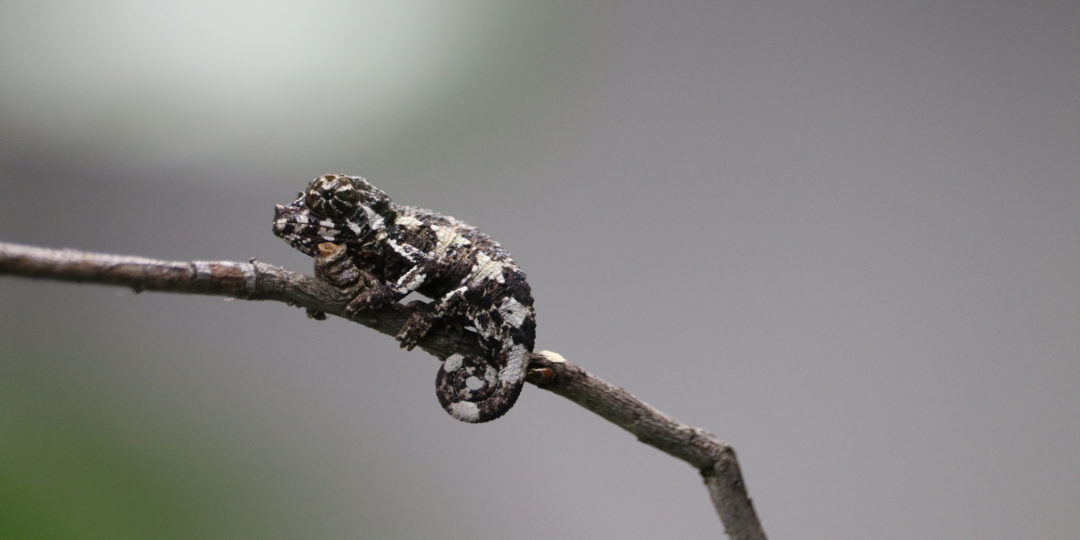
Navigation
This seminar is part of the Jackson’s Chameleon Profile.


